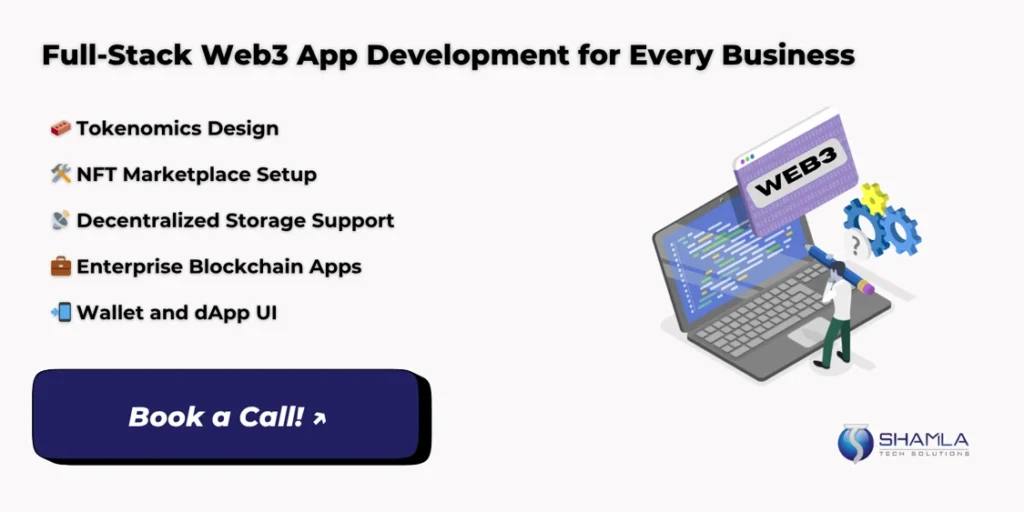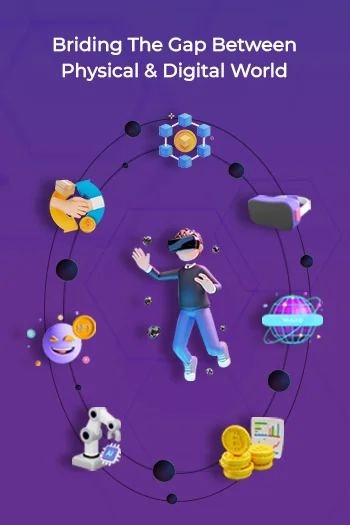In 2025, Web3 helps businesses to use blockchains to run apps without central control. More businesses continue to choose this tech to store data, check identity, and link value directly with users.
Building a Web3 application now changes how companies share data, cut middlemen, and secure transactions. This shift helps shops, banks, and service providers work faster and safer.
In this blog, we look at ten real Web3 projects that businesses are putting into action across fields like finance, health, and supply chains. Each example shows how Web3 application development can solve real needs, cut costs, and open new ways to offer services.
Top 10 Web3 Applications Businesses Are Developing in 2025
1. Decentralized Finance (DeFi) Platforms
Businesses now build DeFi platforms on public ledgers to let people lend and borrow tokens directly. A typical Web3 application uses smart contracts to automate peer-to-peer loans. It sets rules for collateral and interest without banks. Teams write code in Solidity or Rust and test it on testnets before main launch. Yield farming modules let users stake tokens in liquidity pools to earn rewards.
Insurance pools use oracles to trigger claims when data conditions meet. Developers focus on gas fees and scalable sidechains to lower costs. This Web3 application model shows how Web3 app development speeds approval and cuts third-party delays. Firms can launch new money tools without heavy middleman fees. Developers monitor network load and upgrade modules for security.
2. NFT-Based Loyalty and Reward Systems
Brands use NFT-based tokens to boost repeat buys and reward loyal customers. A typical Web3 application links customer wallets to earnable badges. These badges live on public ledgers and show ownership. Companies embed reward logic in smart contracts so users earn points when they shop or stay. Hotels send unique NFT keys that unlock room upgrades and perks. Loyalty dashboards track badge use on mobile apps.
Marketers analyze chain data to spot buying patterns and adjust campaigns. Customers trade tokens on secondary markets, raising program value. This shows how Web3 application development can add true ownership and value. Teams test contracts on sidechains to keep gas costs low. Developers monitor user feedback.
3. Blockchain Supply Chain Trackers
Manufacturers and shippers now track goods on blockchain for clear records. A Web3 application writes each transfer event to a chain, so anyone can verify location and status. Scanners record batch IDs and temperature data into smart contracts. Pharma firms use this to prevent fake drugs and report recalls fast. Food companies log harvest dates and shipment paths automatically. Code checks data on oracles and flags anomalies for review.
Developers use permissioned networks to limit access and protect privacy. Teams focus on modular design and APIs for easy integration with existing ERP systems. This approach shows how Web3 app development brings trust and cuts audit time. Results appear in dashboards for compliance teams. Updates stream live to mobile devices daily.
4. Decentralized Social Media Platforms
New social networks now run on shared open ledgers to avoid control by one group. A Web3 application lets users post and vote on content stored in smart contracts. Data moves across nodes so no single server can ban speech. Communities fund network growth with token sales and earn fees when users engage. Developers build moderation tools using on-chain voting by token holders.
This design cuts risk of bias and lets people choose rules. Firms hire a Web3 app development company to set up DAOs and token models. Apps integrate wallet logins for identity and micropayments. Users gain rewards for quality posts. Open-source code in Web3 application and detailed documentation help add features. These networks protect exchange and data ownership.
5. Web3 Identity Management Systems
Financial and health services now give users control of personal data with self-managed ID tools. A Web3 application stores encrypted identity proofs on a chain user controls. When people need to verify age or credentials, they share signed records without exposing all data. Developers build modules that link wallets to ID wallets and use zero-knowledge proofs for privacy. Governments test these apps to speed license checks and reduce fraud.
Providers use standard APIs to connect with legacy systems for bank accounts or medical records. Teams apply secure key management and multi-signature wallets for recovery. This shows Web3 app development can simplify sign-on and data sharing. Firms invest in Web3 application development to gain user trust and cut compliance costs significantly.
6. Play-to-Earn (P2E) and Metaverse Gaming Apps
Developers build games on blockchains so players own in-game items and earn real tokens. Each user wallet holds NFTs for characters, skins, or land plots. Smart contracts pay tokens when users hit goals or trade items. Teams focus on layer-2 networks to cut transaction fees and speed up trades. Game logic runs in simple scripts so anyone can verify fairness.
Players swap NFTs on open markets, turning play time into real profit. Studios hire a Web3 app development company to link wallets, set up token wallets, and add trading tools. Analytics dashboards track token flow and flag abnormal trades. This Web3 application style gives players true ownership and clear payout rules without gatekeepers.
7. Tokenized Real Estate Platforms
Platforms let many people own parts of a property by issuing tokens on a chain. Each token maps to a share of a building or land. Smart contracts handle rent splits and token trades automatically. Users buy tokens, earn rent payments in stablecoins, or sell shares on peer-to-peer markets. Platforms plug into bank rails for easy cash in and out.
Builders set up clear token rules so investors see fees and share limits upfront. Teams run stress tests on test networks to check contract safety. Detailed guides help users link wallets and complete KYC steps with simple forms. This Web3 application shows how Web3 application development can open property markets to more people.
8. DAO-Based Governance Systems
Groups now use DAOs to vote on budgets, hires, or rule changes. A DAO holds tokens that members use to vote on proposals. Smart contracts count votes and execute decisions when thresholds meet. Proposals live on public ledgers so anyone can see history. Teams add simple interfaces where users click to vote or submit ideas.
Modules run on sidechains to keep fees low and votes fast. Integrations link DAOs with chat apps so discussions and votes happen in one place. Companies partner with experts in Web3 app development to set up token models, snapshot tools, and safe modules. This Web3 application style makes group choices transparent and cuts admin work.
9. Web3-Powered Healthcare Record Systems
Clinics and labs store encrypted patient data on a chain controlled by each person. When a doctor needs records, the patient approves a signed request and shares only needed details. Smart contracts log access events so patients see who viewed their files. Developers use simple APIs to link hospital software with chain wallets.
Zero-knowledge proofs let systems confirm data without showing full records. Teams build recovery tools that let patients restore access if they lose keys. Modules run on permissioned networks so only approved nodes see data. Hospitals work with Web3 application development experts to set up key guards and audit logs. This Web3 application model gives patients control and cuts data leaks.
10. Green Tech and Carbon Credit Marketplaces
Platforms track emissions with sensors that send data to smart contracts. Each verified ton of CO₂ earns a token. Companies buy tokens to match footprints, and projects sell tokens for their cuts. Traders swap credits in open markets without brokers. Developers write simple scripts that check sensor feeds and mint or burn tokens.
Dashboards show live credit supply, demand, and price charts. APIs link weather stations or factory meters to the chain to auto-update values. A Web3 app development company helps set up off-chain oracles and wallet interfaces. This Web3 application lets anyone back green projects and see real impact records.
How Shamla Tech Can Help You Build a Future-Ready Web3 Application
Shamla Tech is a leading Web3 development company that uses clear code and proven tools to deliver secure blockchain apps. We design user wallets, set up smart contracts, and link data feeds. In each Web3 development project, we focus on safety, speed, and easy upgrades, showing our strength in Web3 application development.
We offer ready templates and quick setup so clients launch live apps in weeks. Our Web3 development experts write plain code for node connections, wallet flows, and user dashboards. Shamla Tech helps in guiding every step from ideation to live release. We run daily code reviews, security checks, and network monitoring. Clients gain clear reports and training sessions.
Conclusion
Web3 apps let companies cut middlemen, secure data, and add direct value links with users. They automate processes with on-chain logic, increase data safety with shared ledgers, and open new service models across finance, health, and supply chains. Explore Web3 application use to drive real change. Adopt these tools now.
Partner with Shamla Tech for fast, safe blockchain builds. Our team writes clear code, sets up node networks, integrates wallets, and tests on realnets. We focus on low fees, high uptime, and easy upgrades. Shamla Tech leads Web3 app development, guiding clients from idea to live launch with full support.
Want to build a Web3 app for your business?
Contact us today to get started with expert Web3 development services!





